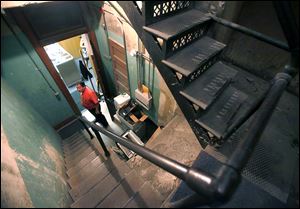
Lucas County Courthouse repair talks begin
Symposium offers suggestions on historic structure
5/15/2014
Two years after Clerk of Courts Bernie Quilter pointed out flaws in the Lucas County Courthouse, county officials are headed to Columbus to begin a discussion of what might be done to preserve the 1897 courthouse one project at a time.
Its sandstone exterior is flaking off in pieces. Wiring for phones and computers runs along the corridor walls, marble panels are discolored, and out-of-date fluorescent lighting illuminates its institutional gray walls.
There’s no question the Lucas County Courthouse needs some attention.
Later today and Friday, a delegation of Lucas County officials will be in Columbus for the Ohio Courthouses Symposium co-hosted by the Ohio Supreme Court. The event is to focus on the value of historic courthouses, explore ways to pay for maintenance and improvements, and address issues such as integrating technology and security in the century-old structures.
Although Lucas County has no plan in place for addressing the needs of its courthouse, Don Colby, common pleas court administrator, said the conference is “an opportunity to start the discussion.”
He will be attending along with Common Pleas Judge Dean Mandros, Clerk of Courts Bernie Quilter, and County Commissioner Tina Skeldon Wozniak. Tom Dodds, capital projects manager for the county, and Peter Ujvagi, chief of public policy and legislative affairs, also are to attend.
Laura Lloyd-Jenkins, county administrator, said the county is interested in learning about funding possibilities and current best practices in the preservation of existing courthouses — “Anything we can find out to start this conversation. The commissioners and I know it’s a much-needed conversation.”
While the county’s tight finances have stood in the way of capital improvements at the courthouse in recent years, Mr. Colby said he’s hoping county officials will be able to begin committing resources to the 1897 building, even if it means doing one small project at a time.
“I’ve been wanting to look at doing something like this since the first day I walked into this building,” said Mr. Colby, who became court administrator in July, 2009.
The symposium, co-hosted by the Ohio Historical Society, the County Commissioners Association of Ohio, Heritage Ohio, and the Columbus chapter of the American Institute of Architects, comes in the wake of the 2012 demolition of Seneca County’s 1884 courthouse following a long and controversial debate.
Two of three county commissioners there ultimately rejected a plan to renovate the Beaux Arts style courthouse with public and private dollars, voting instead to demolish it with no plan in place to replace it.
Chief Justice Maureen O’Connor will deliver the keynote address this evening, followed by a preview of a documentary about the Thomas J. Moyer Judicial Center, home of the Ohio Supreme Court, which was restored 10 years ago.
Among the topics on Friday’s agenda is the economic development potential of courthouses — something that interests Mr. Quilter.
“This is the crown jewel, and so much could be done to make it a tourist attraction,” he said.
Mr. Quilter said visitors come to the courthouse to see its architecture, and many stop in his third-floor office to ask where they can find “the frog.” Just inside the now-closed Adams Street entrance, a frog mosaic is set in the floor, paying homage to Toledo’s swampy beginnings as “Frogtown.”
Mr. Quilter long has been a supporter of the courthouse, a four-story structure that houses 10 common pleas courtrooms, probate court, judicial and clerks offices, as well as the county prosecutor’s office. It is a high-traffic county building, and one that commissioners want to preserve, Ms. Lloyd-Jenkins said.
“The courthouse isn’t going anywhere, so [the question is], ‘What do we need to do to maintain it?’ ” she said.
Contact Jennifer Feehan at: jfeehan@theblade.com or 419-213-2134.